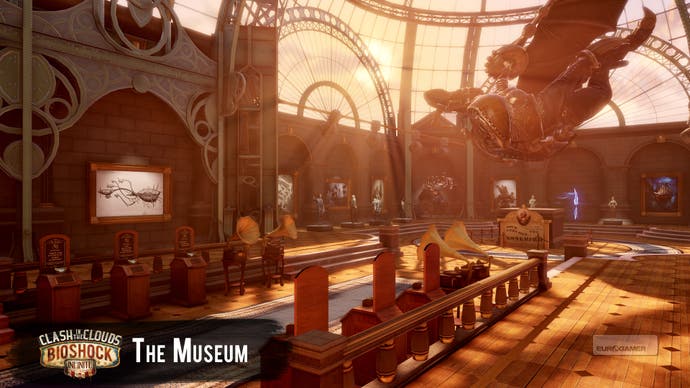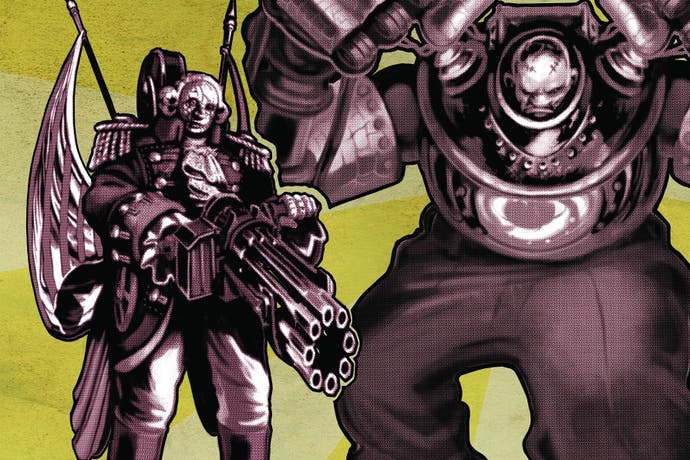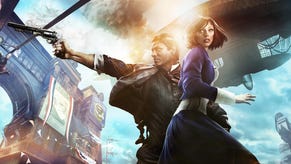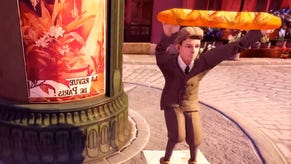BioShock Infinite: Clash in the Clouds review
The first DLC is a wave-based combat game - and it's out today.
First things first: this is not the story-driven new BioShock Infinite adventure for which you were probably hoping. That will come in two parts, the first of which is called Burial at Sea and should be out later this year, and it's there that your dreams will really come true - Booker's a private dick, Elizabeth's a dame with a problem, the two haven't met before, and did I mention it takes place in Rapture before the fall? The fact I'm not making this up is extremely cool.
Before that, though, there's Clash in the Clouds, a five-dollar stopgap that promises a little bit of fan service around the edges, but which is mostly a set of challenges that aim to bring the best out of Infinite's combat, unrelated to the main game except through shared assets and mechanics. If you endured rather than enjoyed the fighty bits of BioShock Infinite, then you might prefer just to look up the secret stuff on YouTube. Me? I loved the combat in Infinite, so this should be right up my street.
Clash in the Clouds is a wave-based arena game, then, where Booker and Elizabeth - now rather mute - team up to see off increasingly devilish combinations of enemies over four maps that have been modelled on, but not directly lifted from, familiar sections of Columbia. Finishing off enemies in creative ways earns points and cash - points go towards fighting your way up a leaderboard, while cash can be ploughed into weapon and vigor upgrades at the hub area you visit between waves.
If that sounds rather basic, it's elevated by another twist - blue ribbon challenges, which set you a secondary objective to complete for each wave. Sometimes you're asked to kill enemies in a certain amount of time, or without taking damage, or with specific weapons and vigors only, or perhaps while zoomed in using scoped weapons. Blue ribbons are optional, but they give you a bonus, not to mention an actual blue ribbon that hangs under a painting of the arena back in the central hub.
More importantly, they get you playing around with weapons and vigors in a way that BioShock Infinite didn't. When the going got tough in the main game, it was too easy to fall back on familiar combinations - Shock Jockey and a souped-up shotgun, for example, or Bucking Bronco and a hand cannon. In Clash in the Clouds, those blue ribbons tempt you to experiment - luring enemies to ledges so you can knock them out of bounds with Undertow, or kiting your adversaries through knots of crow and fire traps when you're denied other means. There are 15 waves per map and there isn't much ribbon repetition.
The initial arena, Ops Zeal, is the simplest, and since Clash in the Clouds gives you access to pretty much the whole Infinite toolkit as soon as you begin and your first adversaries are pretty dumb, it's a gentle start. One of the challenges is to attack using sky-hooks only, while another invites you to kill with just the hand cannon or pistol, and as you dance around, flinging vigors and blowing people's heads off, really you're just playing with your food. It turns out the reason your parents told you to stop that is because it's loads of fun.

It's all very manageable in Ops Zeal, but the other three arenas are bigger and more complex. Duke and Dimwit Theatre draws on Soldier's Field, the Disneyland boardwalk area where you visited the Hall of Heroes, while Raven's Dome is more like the early Raffle Square section of Infinite, and Emporia Arcade is pretty closely modelled on the disintegrating rich district you saw later in the game. Each of these has its moments, but they are a little fiddly to navigate, and it's too easy to lose track of your enemies as you dart around opening tears, hopping onto skylines and fumbling with your shortcut keys.
More to the point, they're much harder. Clash in the Clouds has been designed to present a stiff challenge - it was partly inspired by the apparently positive reaction to the hellacious 1999 Mode that shipped with Infinite - and it isn't shy about killing you fast and frequently. When you die, you're presented with the option to keep going but forfeit your high score, head back to the first wave, or go back to the hub.
You can stave off death by spending a bit of cash to activate a restore point mid-level, and the game is nice enough to let you keep any cash when you die, but it still can't help feel a bit severe, and by the time I reached the later waves on Raven's Dome and Emporia I had stopped paying attention to secondary objectives and fallen back on less creative tactics to bludgeon my way through.

Clash in the Clouds is worth persisting with, however, in order to earn cash to buy up all the delights back in the hub. Down the hall you'll find the Columbian Archaeological Society, where you can spend cash to unlock statues of character models, recordings of Albert Fink's strangely familiar old-time melodies, concept artwork that shows early designs for airships and grand battles, and kinetoscope recordings that show things fans of Infinite itself will deeply appreciate. There are secrets here, too, which aren't too difficult to discover and are the closest thing we'll get to further narrative revelations before we head back down to Rapture later in the year.
The fact we have that to look forward to is welcome, but it also puts Clash in the Clouds in an awkward position. Writing this before the world actually hears about it, I won't be surprised if the initial reaction is mixed, or even negative. Some people will feel it's nice to have new content that brings out the more playful parts of BioShock Infinite's combat toolkit, but all the kinetoscopes and concept art in the world aren't going to satisfy fans who wanted more story - and perhaps felt that that was what they were promised.
Even leaving aside what Clash in the Clouds isn't, however, the reaction may still be mixed. It's pretty good value at just $5, and if you feel as though you mastered the combat in BioShock Infinite and fancy a new, more competitive challenge, it will feel even more valuable and keep you going for quite some time. But while I enjoyed the early sections, prancing around trying the various approaches the blue ribbon challenges nudged me towards, by the end I was too brutalised to continue experimenting and mostly just playing to unlock things.
It's a shame the designers couldn't find a way to keep things casual as well for players who just want to embrace that combat creativity, so potent in the early waves on Ops Zeal. Instead the balance is quickly tipped away from us and Clash in the Clouds becomes another hardcore mode. That's fine, but there was the potential here to draw out the elusive richness of BioShock Infinite's combat and turn it into a series of madcap slapstick challenges. Going hardcore again feels like a narrow interpretation of what made this part of the game good.
As stopgaps go, I'll still take it, but I'm also conscious that I could very well leave it, and simply settle in for the hopefully not-too-long wait for Burial at Sea.

















